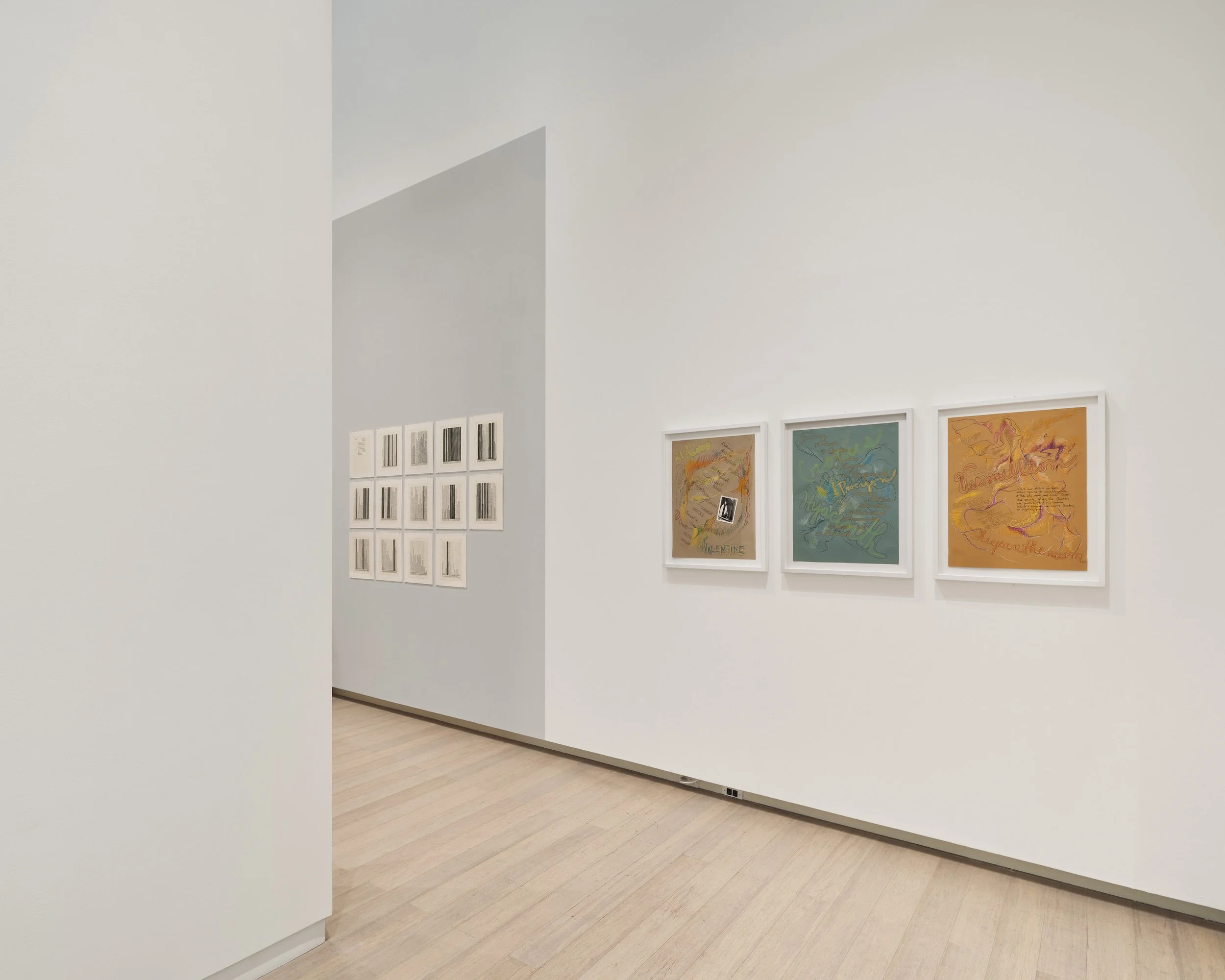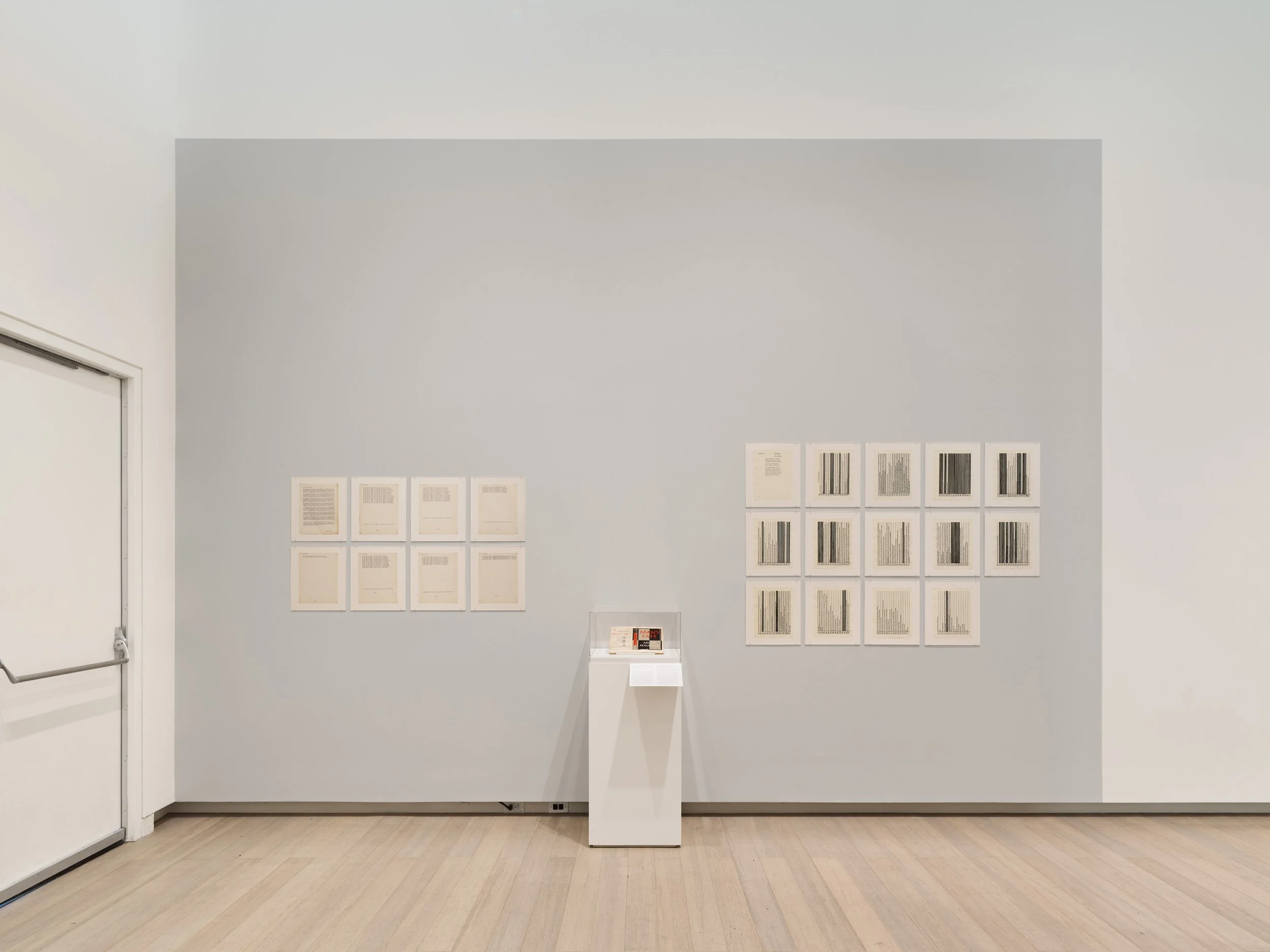Rosemary Mayer’s Image-Text Works
Installation view of "Rosemary Mayer: Words in Art are Signs Returned," on view at the Wallach Art Gallery from March 23 - April 7, 2024. Photograph by Olympia Shannon. Courtesy the Wallach Art Gallery.
In her 1979 artist's book, Some Days in April, Rosemary Mayer wrote, "These words are here, were there, because I still connect them. You would use other words, or do it another way, or not at all." Rosemary Mayer: Words in Art are Signs Returned, an exhibition at the Wallach Art Gallery at Columbia University, turns to Mayer’s lesser-known body of work with the written word, reconsidering the artist’s legacy in relation to feminist and conceptual practices. Curated by Farren Fei Yuan, the exhibition presents a range of Mayer’s image-text work, from large-scale artist’s books and literary magazines to a wall-mounted mixed-media series, displayed for the first time in its entirety.
The show opens with a vitrine displaying the handmade artist’s book, Passages (1976), which documents a three month trip that Mayer took to Europe in her late twenties. A deep red velveteen dustjacket surrounds an inlaid black and white photograph of a classical sculpture, the cover image, followed by selections of the book’s interior pages. She interlays the pages with her collection of postcards, photographs, and notes from England, France, and southern Germany. This ephemera is woven together into book format with reflections and fragments of Mayer’s own family history, collaged photographs, sketches, and genealogical timelines.
Anchoring the exhibition, In Time Order (1978) is a series of twelve drawings representing the months and seasons. The works on paper combine black-and-white photographs and oil crayon illustrations with words – names of saints are drawn colorfully over billowing abstractions, alongside texts written in black ink that read as diary entries: mentions of stars, flowers, neighbors. In the series, Mayer reconstructs and reinterprets linear time: months and seasons are out of order, and her layering suggests alternative perceptions of temporality. The work conveys a level of intimacy similar to that of her artist’s books, or her diaries, intertwining her artistic practice with her personal life, community, and social world.
Mayer grew up in Ridgewood, Queens alongside her younger sister, poet Bernadette Mayer, and went on to study classics at the University of Iowa, where she became fluent in Greek and Latin. It was there that she met and married the artist Vito Acconci, who was pursuing his MFA at the Iowa Writers’ Workshop. Upon graduating, Mayer turned down an offer to pursue a doctorate in classics from Harvard and returned to New York, where she enrolled at the School of Visual Arts. In the years after that, Mayer’s artistic practice developed alongside artists and writers like Hannah Weiner, Nancy Spero, and Adrian Piper, leading figures of the social and intellectual scene of downtown New York in the early 70s. Mayer was enmeshed in avant-garde experimentation and emerging movements like conceptualism, language poetry, and performance art.
These influences become evident in Mayer’s earliest works on view, including her frequent contributions to the literary magazine 0 to 9. The publication, founded by her sister Bernadette Mayer and former partner, Vito Acconci, produced mimeograph print runs that became a critical foundation for the linguistic turn of conceptualism. 0 to 9 published living artists and writers alongside authors whose works were out of print and out of copyright, like Guillaume Apollinaire and Gertrude Stein. The exhibition displays Mayer’s conceptual work, Firecrackers (1969), her contribution to the magazine’s fourth issue, which tallies the sounds of fireworks outside of Mayer’s apartment on the Fourth of July, an experiment in visual poetry that documents the temporal and sonic. In the exhibition’s catalog essay, Yuan references Lucy Lippard’s theory of ‘dematerialization’ and writing by Sol LeWitt, taken from the same 0 to 9 issue: “If words are used, and they proceed from ideas about art, then they are art and not literature.” [1] Mayer’s works on view challenge both theories, defying classification and disciplinary boundaries.
Adrian Piper, who met Mayer through a drawing course at SVA in 1967, writes about their relationship: “I had not yet figured out how to be both an artist and an intellectual…I learned how to do that from Rosemary.” [2] Mayer never abandoned her love for literature and the classics. Instead, she framed them as central to her practice. She cites Bernini, Titian, the Medici, and Homer, alongside Dreams of Rooms, Roses, and Dictionaries as influences. [3] Mayer’s references to historical figures become a motif throughout her image-text works, where she materializes her engagement with the past.
Her medium for making was writing. Another vitrine displays the artist’s book, Diary of Jacopo da Pontormo Written During the Time He Painted the Choir at San Lorenzo (1976), Mayer’s translation of the Mannerist painter Pontormo’s diary, which she overlaid with drawings of figures inspired by Pontormo’s works. The entries are mundane, and timeless – Pontormo records meals, weather, physical ailments. In content, they are not dissimilar from Mayer’s own diary entries. Another section of the exhibition shows Mayer’s contribution to Surroundings, an artist’s issue made for ART-Rite in 1977, where Mayer weaves together a nonlinear narrative between Pontormo and a fictional woman named Florence through dynamic collages of drawings, tarot cards, and poetry. These works embody monumental time, Kristeva’s second temporal modality: an eternity that Mayer locates in her practice, moving diagonally across time and space. [4] The publication format is the vehicle through which Mayer reveals that boundary-breaking confluence of the written and the visual.
These image-text works vigorously attempt to rupture or break time altogether. Mayer moved through the world parachronistically, discerning the present through chronological misplacements. Time, for her, was never linear. The synthesis of writing and image throughout her body of work was an act of defiance, a rejection of historical and disciplinary conventions.
Reinterpreting existing forms, Mayer practices what art historian Catherine Grant refers to as an anachronizing feminism, the strangeness that emerges from disparate moments of time coming together. [5] As Mayer layers and collages the visual and textual, she confounds time through forms of embodied engagement with the past to reinhabit history. The exhibition reveals a shadow side of Mayer’s artistic oeuvre across translation, letter writing, and diary keeping, where Mayer solidified space for herself that functioned outside of history.
[1] Sol LeWitt, “Sentences on Conceptual Art,” 0 to 9, 5 (January 1969), 4, quoted in Farren Fei Yuan, “Rosemary Mayer: ‘Words in Art Are Signs Returned’” (New York, Wallach Art Gallery, Columbia University, 2024).
[2] Adrian Piper, “Rosemary Mayer (1943-2014),” Artforum, December 11, 2014.
[3] Alice Butler, “Too Likeable (To the Side of Rosemary Mayer), Part II,” MAP Magazine, August 2022, 66.
[4] Julia Kristeva, “Women’s Time,” Signs 7, no. 1 (1981): 13–35.
[5] Catherine Grant, A Time of One’s Own: Histories of Feminism in Contemporary Art (Durham London: Duke University Press, 2022).
Installation view of "Rosemary Mayer: Words in Art are Signs Returned," on view at the Wallach Art Gallery from March 23 - April 7, 2024. Photograph by Olympia Shannon. Courtesy the Wallach Art Gallery.
Installation view of "Rosemary Mayer: Words in Art are Signs Returned," on view at the Wallach Art Gallery from March 23 - April 7, 2024. Photograph by Olympia Shannon. Courtesy the Wallach Art Gallery.
Installation view of "Rosemary Mayer: Words in Art are Signs Returned," on view at the Wallach Art Gallery from March 23 - April 7, 2024. Photograph by Olympia Shannon. Courtesy the Wallach Art Gallery.


